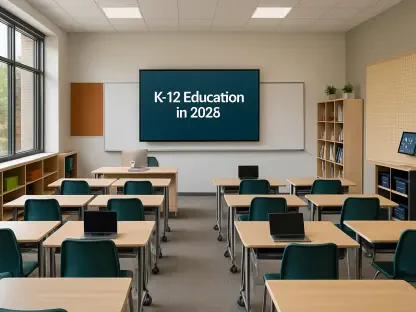In recent years, there has been a significant rise in misogyny infiltrating educational settings, fueled largely by online culture and influential social media figures like Andrew Tate. This trend poses serious challenges for educators striving to maintain respectful and inclusive environments. The presence of sexist and disrespectful commentary by students in classrooms disrupts teaching dynamics, creating hostile atmospheres and undermining positive social interactions among peers. Teachers like Christine Emberley from Halifax have noted an alarming increase in derogatory remarks, particularly among male students, which underscores a concerning proliferation of anti-feminist sentiment. This development is detrimental to fostering a supportive learning environment and reflects broader societal issues influenced by digital mediums.
Online platforms and social media algorithms inadvertently expose young males to misogynistic content, often cloaked in innocuous presentations. This phenomenon is corroborated by studies such as those conducted by Luc Cousineau, which point to a troubling correlation between online engagements and disrupted educational settings. These observations give rise to a pressing question: can education effectively counteract the real-world implications of digital misogyny? Many educators and researchers argue for systemic changes, including policy updates and curriculum revisions aimed at addressing gender-based prejudices. These efforts must seek to provide students with critical thinking skills and media literacy that empower them to recognize and reject harmful ideologies.
Influence of Social Media and Celebrities
With the rise of social media influencers like Andrew Tate, promoting lifestyles rooted in misogyny, society faces a formidable challenge in mitigating their impact on impressionable audiences. Tate’s rhetoric glorifies a skewed representation of masculinity, which continues to attract and inspire young male followers despite legal accusations against him. Such figures have succeeded in disseminating narratives that glamorize a culture of male dominance, posing significant difficulties for educators attempting to cultivate environments that prioritize mutual respect and equality. The intricacies of these digital influences are critical to understanding the broader socio-cultural dynamics at play in educational settings today.
The amplification of misogynistic content through algorithm-driven platforms can inadvertently influence young minds, contributing to the normalization of such ideologies. Lance McCready, an associate professor at the Ontario Institute for Studies in Education, advocates for a shift toward positive portrayals of masculinity beginning in early childhood. His perspective stresses the importance of fostering discussions about gender and masculinity within educational curricula, encouraging dialogues that challenge the problematic stereotypes promoted by influencers like Tate. McCready’s approach emphasizes a proactive stance, seeking to offer boys and young men alternative role models that contradict harmful narratives prevalent online.
Socio-Political Climate and Educational Challenges
The rise of specific political movements has led to the legitimization of anti-feminist rhetoric, complicating the task of addressing such ideologies within educational settings. Cornelia Schneider from Mount Saint Vincent University’s department of education highlights how these developments have afforded platforms to extremist voices, now thriving with increased visibility and legitimacy. This climate has been further augmented by rapid advancements in social media, facilitating the pervasive spread of misogynistic content. Tackling these challenges necessitates a comprehensive understanding of the socio-political context, as educators strive to respond effectively to the evolving landscape.
Addressing the complexity of this issue requires a multifaceted approach that transcends regional efforts. Christine Emberley’s experience demonstrates the need for cultivating empathy and curiosity within classrooms, serving as a microcosm of broader societal change. While educators initiate these shifts, there is a need for systemic reforms to back these individual efforts. This might include integrating gender-based violence awareness and response frameworks into educational policies and curricula. The example set by Nova Scotia in updating their curriculum in response to societal events underscores the potential impact of such reforms in addressing pervasive societal challenges head-on.
Moving Toward Unified Solutions
The intricate problem of misogyny infiltrating educational settings via online culture is complex and multifaceted, demanding a united approach across jurisdictions. Research by Cousineau highlights the necessity for comprehensive solutions that incorporate social conditions and the global influence of media. Without coordinated efforts that transcend local policies, endeavors risk fragmentation and ineffectiveness at large scales. The consensus among educators and researchers remains focused on innovative strategies that collectively address the convergence of tech influence and social movements impacting educational environments.
This consensus calls for an integration of educational policy, media literacy, positive role modeling, and open dialogue among educators, students, and communities. These multifaceted approaches aim to dismantle harmful stereotypes, promoting a culture of respect and equity within educational settings. Education must evolve to counteract the insidious effects of digital misogyny, reinforcing the foundational values of empathy and mutual respect. By cultivating critical thinking skills and fostering open dialogue, educators hope to defend against the negative influences that threaten the integrity of the learning environment.
Building a More Respectful Environment
Misogyny has seeped into educational settings, largely driven by online culture and influential figures on social media like Andrew Tate. This trend brings significant challenges for educators who strive to maintain respectful, inclusive learning environments. Sexist and disrespectful comments by students disrupt classroom dynamics, creating hostile atmospheres and undermining positive peer interactions. Teachers such as Christine Emberley from Halifax have noticed an alarming rise in derogatory remarks, particularly among male students, highlighting the spread of anti-feminist sentiments. This issue hampers the creation of supportive learning surroundings and mirrors broader societal problems fueled by digital channels. Online platforms and social media algorithms inadvertently expose young males to misogynistic content, often veiled in seemingly harmless forms. Studies, including those by Luc Cousineau, reveal a troubling link between online activities and disruption in schools, raising the question: can education counter digital misogyny’s real-world effects? Many call for systemic changes, policy updates, and curriculum revisions to tackle gender biases. Emphasizing critical thinking and media literacy, these initiatives aim to empower students to recognize and reject harmful ideologies.









